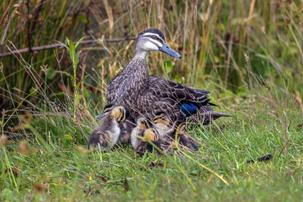This unit is designed to introduce younger students to the concept of biodiversity and the different organisms that can be found in their school environment. The unit includes a variety of activities such as making a mural, observing bugs in the garden, creating a mini worm farm, and conducting investigations to answer questions about biodiversity. Students will also learn about different types of animals and their habitats, as well as ways to protect and conserve the environment. The unit incorporates hands-on activities, art and writing exercises, and role-playing to engage students and promote their understanding of biodiversity.

Discovering Biodiversity
- Primary
- Year 1 - 2
- English
- Mathematics
- Science
- Environmental
- Biodiversity
- ...
Tune in
- Lesson
- ...
Let's make a forest ecosystem
- Primary
- Year 1 - 2
- Science
- Environmental
- Biodiversity
- Climate Change
- Sustainability
- Lesson
- ...
Frog in a pond game
- Primary
- Year 1 - 2
- Science
- Environmental
- Biodiversity
- Climate Change
- Sustainability
- Lesson
- ...
What sort of animal is that?
- Primary
- Year 1 - 2
- Science
- The Arts
- Environmental
- Biodiversity
- Climate Change
- Sustainability
- Lesson
- ...
Make a big biodiversity book
- Primary
- Year 1 - 2
- The Arts
- Visual Arts
- Environmental
- Biodiversity
Find out
- Lesson
- ...
Cool questions and activities about wildlife
- Primary
- Year 1 - 2
- English
- Science
- Environmental
- Biodiversity
- Climate Change
- Sustainability
- Lesson
- ...
Busy birds
- Primary
- Year 1 - 2
- Science
- Environmental
- Biodiversity
- Climate Change
- Sustainability
- Lesson
- ...
Can you smell it?
- Primary
- Year 1 - 2
- English
- Science
- Environmental
- Biodiversity
- Climate Change
- Sustainability
- Lesson
- ...
Colours, shapes and patterns
- Primary
- Year 1 - 2
- Mathematics
- Science
- Environmental
- Biodiversity
- Climate Change
- Sustainability
- Lesson
- ...
Don't let them bug you!
- Primary
- Year 1 - 2
- English
- Science
- Environmental
- Biodiversity
- Climate Change
- Sustainability
- Lesson
- ...
Who needs a tree?
- Primary
- Year 1 - 2
- Science
- Environmental
- Biodiversity
- Climate Change
- Sustainability
- Lesson
- ...
Friend or foe?
- Primary
- Year 1 - 2
- Science
- Environmental
- Biodiversity
- Climate Change
- Sustainability
- Lesson
- ...
How Can We Help Animals and Plants?
- Primary
- Year 1 - 2
- English
- Science
- Environmental
- Biodiversity
- Climate Change
- Sustainability
Take action
- Lesson
- ...
My promise
- Primary
- Year 1 - 2
- English
- Science
- Environmental
- Biodiversity
- Climate Change
- Sustainability
- Lesson
- ...
Setting up a bird bath
- Primary
- Year 1 - 2
- Mathematics
- Science
- Environmental
- Biodiversity
- Climate Change
- Sustainability
Save
Share this lesson
Copy Link
Copied
Share
Welcome back!
Don't have an account yet?
Log in with:
By signing up to Cool.org you consent and agree to Cool's privacy policy to
store, manage and process your personal information. To read more, please see
our privacy policy here(Opens in new tab).
Create your free Cool.org account.
Many of our resources are free, with an option to upgrade to Cool+ for premium content.
Already have an account?
Sign up with:
By signing up to Cool.org you consent and agree to Cool's privacy policy to
store, manage and process your personal information. To read more, please see
our privacy policy here(Opens in new tab).